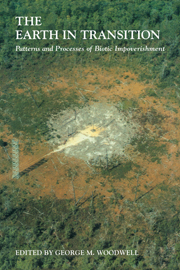Book contents
- Frontmatter
- Contents
- Preface
- Acknowledgments
- List of Contributors
- Part I Global Change and the Patterns of Impoverishment
- Part II Chronic Disturbance and Natural Ecosystems: Forests
- 8 The Restoration of Nonsuch Island as a Living Museum of Bermuda's Precolonial Terrestrial Biome
- 9 Patterns of Impoverishment in Natural Communities: Case History Studies in Forest Ecosystems – New Zealand
- 10 Changes in the Eucalypt Forests of Australia as a Result of Human Disturbance
- 11 Impoverishment in Pacific Island Forests
- 12 Deforestation in Brazilian Amazonia
- 13 Incentives for Sustainable Forest Management
- Part III Chronic Disturbance and Natural Ecosystems: Woodlands, Grasslands, and Tundra
- Part IV Chronic Disturbance and Natural Ecosystems: Aquatic and Emergent Ecosystems
- Part V Conclusion: Steps toward a World That Runs Itself
- Name Index
- Subject Index
9 - Patterns of Impoverishment in Natural Communities: Case History Studies in Forest Ecosystems – New Zealand
Published online by Cambridge University Press: 24 November 2009
- Frontmatter
- Contents
- Preface
- Acknowledgments
- List of Contributors
- Part I Global Change and the Patterns of Impoverishment
- Part II Chronic Disturbance and Natural Ecosystems: Forests
- 8 The Restoration of Nonsuch Island as a Living Museum of Bermuda's Precolonial Terrestrial Biome
- 9 Patterns of Impoverishment in Natural Communities: Case History Studies in Forest Ecosystems – New Zealand
- 10 Changes in the Eucalypt Forests of Australia as a Result of Human Disturbance
- 11 Impoverishment in Pacific Island Forests
- 12 Deforestation in Brazilian Amazonia
- 13 Incentives for Sustainable Forest Management
- Part III Chronic Disturbance and Natural Ecosystems: Woodlands, Grasslands, and Tundra
- Part IV Chronic Disturbance and Natural Ecosystems: Aquatic and Emergent Ecosystems
- Part V Conclusion: Steps toward a World That Runs Itself
- Name Index
- Subject Index
Summary
Editor's Note: New Zealand, isolated 80 million years ago by the vagaries of continental drift, blessed with a high degree of endemism as a result of the isolation, and protected from human depredations until about 1,000 years ago, offers a window on the effects of rampant mismanagement of an especially vulnerable flora and fauna. The most conspicuous transition was the destruction of the lowland forests by Polynesian settlers and the replacement of the forests with fernlands, shrublands, and tussock grasslands. But the introduction of exotic mammals, apart from humans, has been an almost equivalently destructive force, changing plant and animal communities throughout the islands. The changes have been the more profound in that the indigenous plants and animals were of the large-bodied, slowly reproducing forms that are most vulnerable to disruptions.
The principal solution advanced by Mark and McSweeney is a more elaborate system of reserves. The lessons from New Zealand are many and rich. The danger is that they will be seen as peculiar to that entrancing place and not the window on the world that they are.
Introduction
The continuous isolation of New Zealand since its separation from the Gondwanaland supercontinent during the upper Cretaceous era has allowed preservation of unique archaic elements among its limited indigenous biota.
Three periods in the recent past have had important influences on the current biota. Some of the ancient biota became extinct during the Pleistocene glaciations.
- Type
- Chapter
- Information
- The Earth in TransitionPatterns and Processes of Biotic Impoverishment, pp. 151 - 176Publisher: Cambridge University PressPrint publication year: 1991

